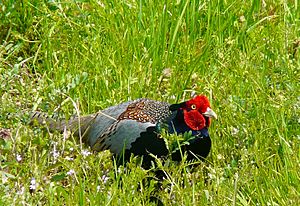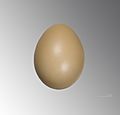Green pheasant facts for kids
A green pheasant (scientific name: Phasianus versicolor) is a beautiful bird that lives only in Japan. It is very special because it is Japan's national bird! This means it's an important symbol for the country.
Contents
What is a Green Pheasant?
The green pheasant is a type of pheasant, which is a group of large, colorful birds. It is closely related to the common pheasant, but it has its own unique look. These birds are known for their stunning feathers and their shy nature.
Appearance
Male green pheasants are very striking. They have shiny, dark green feathers on their bodies, especially on their chests and backs. Their necks are purple-violet, and their heads are green with a reddish-purple patch around their eyes. They also have a long, striped tail. Female green pheasants are much less colorful. They have duller, brownish feathers with black spots, which helps them blend in with their surroundings. This camouflage is important for hiding from predators, especially when they are nesting. Males are also larger than females.
Where They Live
Green pheasants are found all over the main islands of Japan, including Honshu, Shikoku, and Kyushu. They prefer to live in open areas like farmlands, grasslands, and light forests. You might spot them near rivers or in bushy areas where they can find food and shelter. They are very good at hiding in tall grass and can run very fast when they feel threatened.
What They Eat
Green pheasants are omnivores, which means they eat both plants and small animals. Their diet includes seeds, grains, insects, and small worms. They often search for food on the ground, scratching with their strong feet to uncover tasty treats. Farmers sometimes see them in their fields, looking for fallen seeds after harvest.
Life Cycle and Young
Green pheasants usually start their breeding season in spring. The male pheasant will try to attract a female with his bright feathers and special calls. After mating, the female builds a simple nest on the ground, often hidden in thick vegetation. She lays a clutch of eggs, usually between 6 and 10. The eggs are a pale olive-brown color. The female incubates the eggs, meaning she sits on them to keep them warm, for about 23 to 25 days until they hatch.
When the chicks hatch, they are covered in soft downy feathers and can walk and feed themselves almost immediately. This is called being "precocial." The mother pheasant takes care of her young, teaching them how to find food and protecting them from danger. The young pheasants grow quickly and are ready to fly and become independent after a few weeks.
Images for kids
See also
 In Spanish: Faisán verde para niños
In Spanish: Faisán verde para niños





